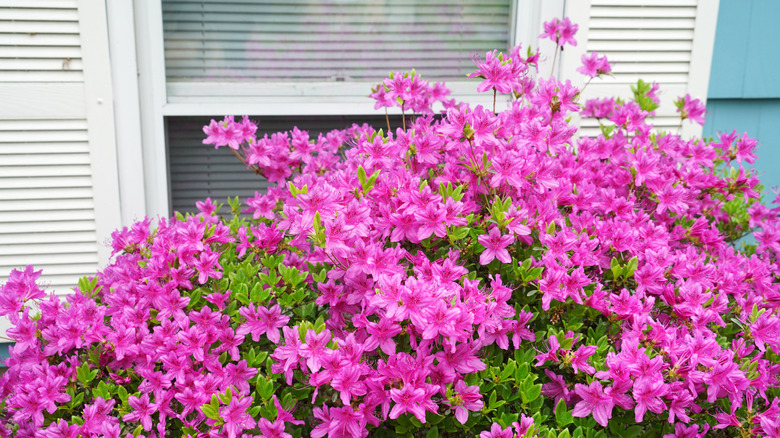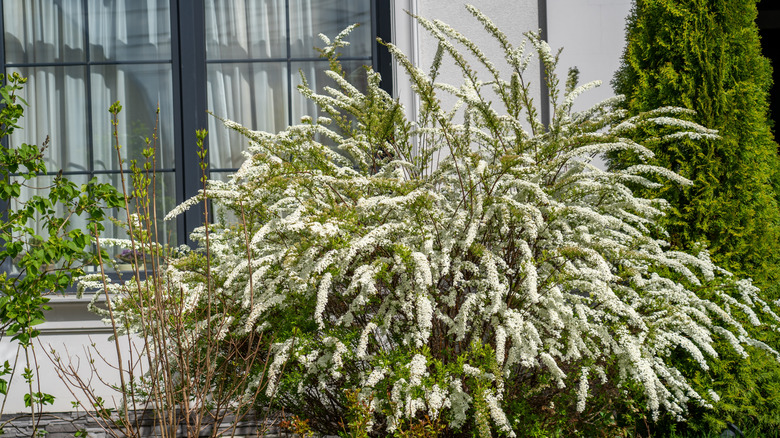10 Beautiful Privacy Shrubs You'll Want To Grow Right Next To Your Windows
There's something effortlessly aesthetic about looking out your window and seeing a little slice of green with bursts of blooms between you and the rest of the world. Maybe it's the way leafy branches filter the sunlight into soft, dappled patterns across your floor, or how a spray of blossoms makes the view outside feel like you're living in a fairytale. Privacy shrubs don't just keep peepers at bay, but they can create a sense of calm, framing your windows in color and texture, while offering oodles of birds, butterflies, and other pollinators a pretty place to visit.
Shrubs growing in front of your windows become part of your home's personality. They can be stately and polished, with evergreen foliage that looks sharp all year, or free spirited and shape shifting with every weather change. There are plenty of blooming flowering trees that dazzle with lasting color, but the right plant can give you fast-growing coverage and curb appeal without the fussiness. Whether you love the nostalgic fragrance of lilacs drifting through the kitchen, the jewel-like berries of beautyberry glowing against a backdrop of foliage, or the classic enchantment of camellias opening just outside your windowpane from October to May, there's a bushy, flowering shrub for every scene. From blooming showstoppers to heat-tolerant evergreens, the privacy shrubs below offer a splash of color, a waft of scent, or a green curtain that can make your home feel a little more like a sanctuary.
Camellia
Camellias (Camellia) are elegant, timeless, and full of surprises. Their glossy evergreen leaves create a lush backdrop year-round, but it's the blooms that steal the spotlight. Depending on the variety, you'll get lush, rose-like flowers in shades of pink, red, or white from fall through early spring, just when most plants are taking a break from the show. They're hardy in zones 6 through 9 and can grow as tall as 20 feet.
Gardenia
Reaching up to 8 feet in height, gardenias (Gardenia jasminoides) are pure romance in plant form, featuring lush, glossy leaves paired with creamy white blooms that smell like a bottled-up summer night. They work well as privacy shrubs and give your landscape year-round greenery, while their flowers, which appear in late spring and again in summer, add a touch of elegance that feels almost cinematic. Make sure you know which plants you should and shouldn't plant near gardenias. They thrive in zones 7 through 11.
Azalea
Azaleas (Rhododendron) will burst onto the scene with clouds of vibrant blooms in pink, red, purple, or white just when you're craving color the most in spring. Their flowers can be so abundant that they nearly hide the leaves, creating a living bouquet right outside your window. Azaleas can grow up to 10 feet tall and thrive in partial shade in zones 4 through 8, making them a low-fuss yet high-impact pick for brightening up your view and adding cheerful privacy to your landscape.
Hydrangea
Hydrangeas (Hydrangea) are shape shifters, changing their bloom colors in some varieties depending on the pH of soil, from soft blues to vibrant pinks. Their oversized, cloud-like clusters of flowers appear in summer and can last well into fall, creating a lush, aesthetic view right outside your window. Hydrangeas thrive in zones 3 through 9 and offer an easy way to make any window view feel like a postcard.
Spirea
Spirea is a cheerful overachiever. During warmer months, it bursts into clouds of tiny blooms in white, pink, or soft rose hues, often so abundant they nearly blanket the foliage. But by fall, its blooms fade but the leaves assume shades of gold, orange, or red. The popular blooming shrub grows best in zones 3 through 9, with a mounded shape and dense growth that gives you a whimsical layer of privacy without feeling heavy.
Beautyberry
Beautyberry (Callicarpa) shrubs live up to their name. In late summer to fall in zones 6 through 10, the shrub's branches sprout clusters of vivid, jewel-like purple berries that seem to glow against the green leaves. These berries linger into winter, feeding birds and adding a pop of unexpected color when the rest of your garden looks bleak. By spring, beautyberry's arching form, which can reach up to 8 feet, creates an informal privacy screen in front of your window.
Cherry laurel
Cherry laurel (Prunus laurocerasus) shrubs are dense, evergreen, and exactly what you'd want growing in front of your window. Their glossy, deep-green leaves form a thick screen year-round, making them perfect for blocking unwanted views. In springtime, cherry laurel surprises you with fragrant clusters of small white flowers, followed by dark berries that attract flocks of beautiful robins to your backyard. Hardy in zones 6 through 8, the fast-growing and adaptable cherry laurel can be shaped into a formal hedge or left to grow naturally.
Lilac
Lilacs (Syringa vulgaris) fill the air with a sweet, unmistakable fragrance that instantly feels like warm weather and mimosas. These hardy shrubs offer a lush, leafy backdrop, giving you a natural and super pretty privacy screen. Lilacs are remarkably low maintenance once settled in and are hardy in zones 3 through 7. Once they're mature, lilac shrubs can grow as tall as 15 feet, with a 12-foot width.
Chastetree
The chastetree (Vitex agnus-castus) is a sun-loving beauty that brings a little Mediterranean flair to the garden. Its tall, spiky clusters of lavender-blue blooms not only look eye-catching but also appeal to pollinators like butterflies and bees. With the ability to grow up to 20 feet high, its airy branches let light filter through while still giving you a sense of privacy. Chastetree thrives in heat and shrugs off drought once established. It's hardy in zones 7 and 8.
Crape myrtle
Crape myrtles (Lagerstroemia indica) are July-to-September bloomers that can light up your landscape in dazzling colors, like pink, purple, red, and white. These versatile shrubs (or small trees) thrive in sunny spots, specifically in zones 6 through 9. They can grow up to 30 feet tall, so whether you plant one as a focal point outside your window or group several as a vibrant privacy screen, crape myrtles bring a pretty year-round aesthetic.










